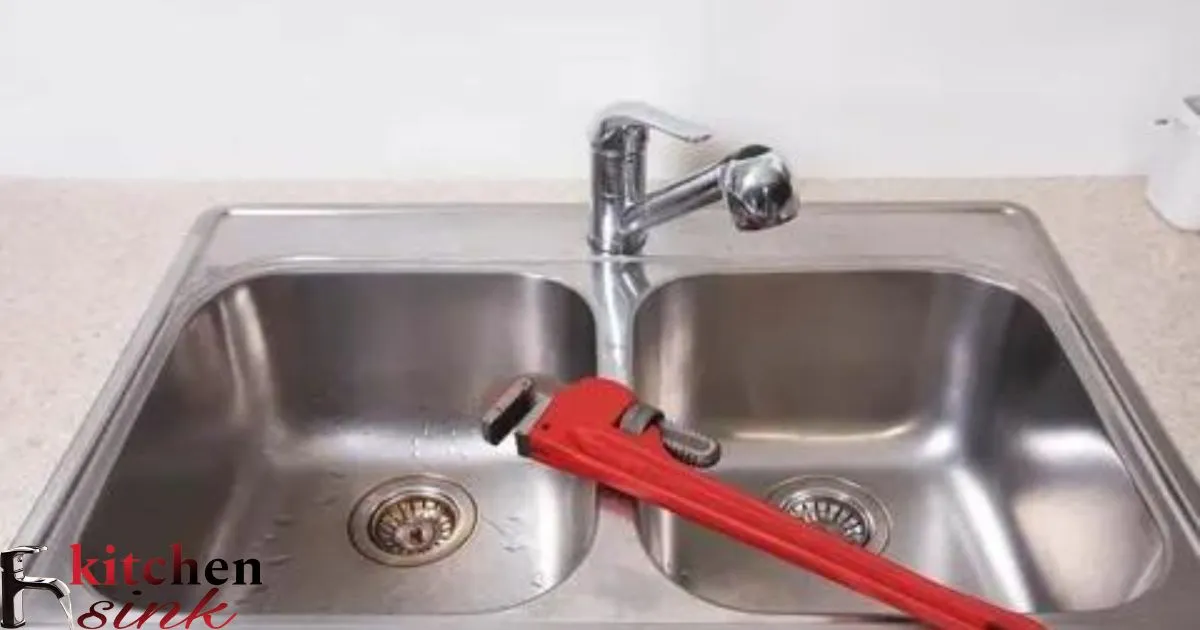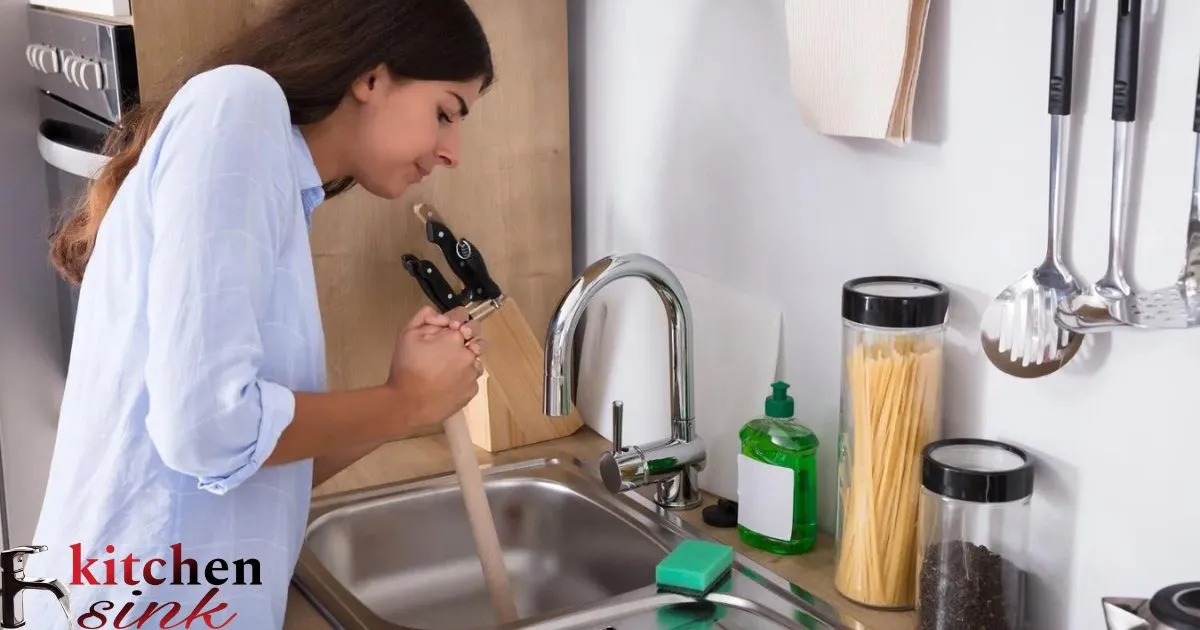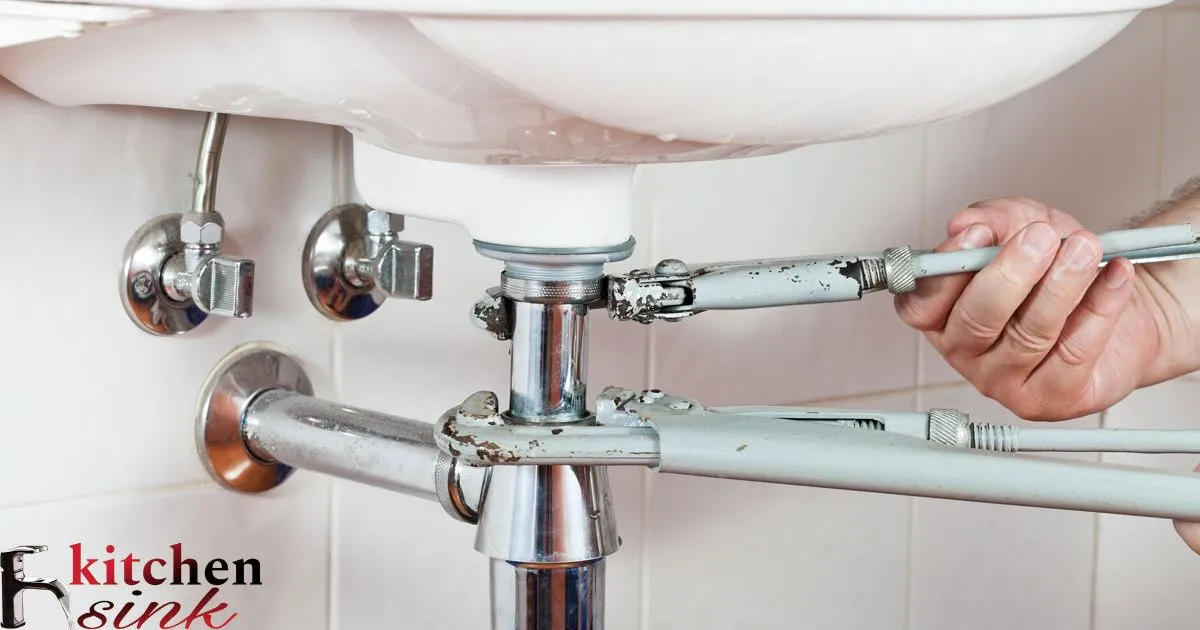A double kitchen sink refers to a sink unit with two separate basins, providing more space for washing dishes and food preparation. It’s commonly installed in kitchens to facilitate multitasking and efficient cleanup, allowing users to separate tasks such as washing and rinsing.
Is your kitchen sink causing you headaches with its double clog? Say goodbye to frustration with our simple solution! Discover the easiest way to unclog your double kitchen sink in just a few steps. Don’t let blockages ruin your day – take action now and enjoy hassle-free kitchen chores again!
Learn the simple steps to clear a double kitchen sink blockage effortlessly. With our easy-to-follow guide, you’ll have your sink flowing smoothly again in no time. Say goodbye to clogs and hello to hassle-free dishwashing!
Clogging The Kitchen Sink
There are many possible causes for a clogged kitchen sink. Food, hair, and grease are common culprits that can cause drain clogs if not handled properly. The first step is to determine what type of material is stuck and blocking water flow. Careful examination of the drain can reveal clues about the source.
Examining what you previously poured or washed down the sink also provides hints about the clog cause. Have there been many greasy pots recently or was long hair washed without a strainer? Don’t assume until visually checking to see any visible signs of the blocking material. Narrowing down the type of clog helps choose the best method to remove it.
Food Scraps In The Disposal
Many kitchen clogs are due to food items not being chopped finely enough before using the garbage disposal. Large chunks of food get wedged and start accumulating. Turning on the disposal with the drain plug removed allows inspecting for obvious particles.
Running hot water with the disposal can help break up scraps too large to shred. Turn it on after adding a bit of baking soda or lemon juice to help cut through grease. If a collection of gunk is visible, work on removing it with tongs or a drain cleaning tool before using chemicals or specialized devices. Food is often the easiest type of clog to clear.
Hair Clogging The Drain
Excess hair is a common culprit for drain clogs. Look inside the drain opening to see if any hair clumps or strands are visible. Hair easily washes down but gets tangled in the pipes. Fix Water Pressure In Kitchen Sink Using a strainer whenever hair is washed can catch most before entering the drain.
If hair is the cause, special tools may be needed for removal. Snake drain cleaners are effective for removing built up hair. Soaking the clog area with hair removal products like drain enzymes or baking soda/vinegar mixtures also helps. Brushing or plunging usually won’t fully remove large matted hair clogs. Gentle tools or chemicals are safer to use than force.
Grease Buildups In The Pipes
Grease is notorious for congealing into hard blockages over time. Look around the drain and pipes for signs of past grease deposits. Check inside the P-trap if removable for built up residue signs.
Traces of dried greasy film indicate a gradual accumulation leading to reduced flow. Hot soapy water may loosen small amounts but mineral oil products or specialty drain cleaners work best on hardened grease clogs. It’s important to pour these directly on the grease clump rather than just down the drain for direct contact. Scrubbing aids in breaking down the grease.
Other Items May Be Causing Clogs
Occasionally drains can get blocked by non-food items as well. Look for obvious objects and pull out anything removable sitting in the drain trap area. Common culprits includes things like lost toys, dropped jewelry or buttons, coins, and hair accessories.
Natural shedding like leaves, mulch or plants can also cause issues if entering drains outdoors. Chemical drainage like expired household cleaners poured improperly can lead to strange clogs too. Its best to avoid unusual flushable items and chemicals to begin with for easiest cleanup later on. Identifying what doesn’t belong helps rule out root causes.
Clear Small Clogs In The Kitchen Sink
A plunger is often the first line of attack for minor drain clogs. Place the plunger firmly over the drain hole and pump rhythmically to build pressure. The forceful suction can dislodge loose particles blocking water flow.
Baking soda or vinegar are natural drain clearers safe for most pipes. Pour a cup of one straight down the drain, then follow with a pot of boiling water. This mild acid/base reaction can dissolve debris better than warm water alone. Repeat as needed if the drain hasn’t fully reopened. Small issues are easiest remedied without chemical drain cleaners.
Use A Plunger On My Double Kitchen Sink
5 easy short paragraphs on using a plunger on a double kitchen sink
- Place the plunger firmly over one of the drain holes. Make sure it creates a good seal all the way around the drain opening. Gently pump the plunger up and down to create pressure changes in the pipe.
- If the clog is only in one side, focus the plunger on that drain. You may clear it after a few pumps. If water doesn’t start draining, move to the other drain hole and try plunging there as well.
- For a widespread double sink, use a special plunger made for double bowl sinks. It will create suction over both drain holes at the same time. Push and pull the plunger vigorously to try and dislodge debris.
- Keep plunging for 30 seconds to a minute at a time. Take breaks in between to allow any loosened material to wash away. Repeat as needed until water runs freely down both drains.
- Have a towel handy to wipe up any water splashes from plunging. Go slow, using steady pressure rather than slamming the plunger which could damage pipes or surfaces. Be patient, and plunging can solve many minor sink clogs.
Baking Soda And Vinegar Clear Small Clogs
Baking soda or vinegar are effective natural drain cleaners for softening debris. Pour 1/2 cup baking soda down the drain, then slowly add 1/2 cup white vinegar. Stand back while it fizzes – this chemical reaction can splash. Let it sit for 15 minutes before flushing with boiling water.
The mild acidity or alkalinity helps dissolve residue better than water alone. It’s especially useful for removal of organic matter like food and hair. Repeating a few times allows it to fully work through stubborn small blockages. Baking soda also deodorizes dried clogs to freshen pipes.
Tools Are Best For Snaking Small Clogs
Flexible drain snakes with twisted metal or plastic construction are great for grabbing hold of small debris or hair. They come in longer and shorter sizes – 12 inches handles most domestic sinks. Lubricating the coil eases guiding it into hard to reach pipes.
Plunger style drain snakes fit securely over the drain opening while short bristled pipes scrub away residue. These mechanical options are safer for pipes than strong chemicals if overused. But for light use, natural remedies often work as well without special gear. Starting simple is recommended before buying extra tools.
Prevent Small Clogs From Reoccurring
Routine maintenance keeps drains flowing freely. Monthly baking soda scrubs dissolve any lingering residue. Occasionally running very hot water helps sanitize and reflush. Having sink strainers catches food/hair catches most solids.
Pouring fats/oils into a jar instead of the sink aids disposal. Avoid harsh chemicals and flush only necessary solvents with ample water. Catching problems early prevents major backups requiring a plumber. Basic upkeep makes future drain clearing an easy do-it-yourself task.
Completely Clear A Clog In The Double Sink Drain
Stubborn clogs deeper in the shared drain will require stronger measures. Try an entire box of baking soda followed by vinegar and boiling water. This supercharged reaction may fully dissolve what remains.
Let it sit overnight if the blockage was severe. In the morning, run hot water and check drainage. If still slow, stronger chemical options may now be needed to complete the job.
Try A Chemical Drain Cleaner
Harsher drain cleaners containing acid or lye fully clear stubborn material better than milder remedies alone. Only use them if simpler methods failed after multiple attempts. Wear gloves and eye protection as these substances can irritate skin/eyes if not handled carefully.
Work in a well ventilated area and never mix different drain cleaning chemicals. Only pour recommended amounts straight down the drain to directly contact clogs. Follow safety warnings and neutralize drains after with vinegar or water before future use. Chemically dissolved clogs often don’t reoccur.
Tools Do I Need For Deep Drain Snaking
A closet auger or drain snake with a long flexible coil attached to a rotating crank handle allows accessing lines. Measure the pipe diameter first and select a snake 1/2 inch smaller. Apply plumber’s grease to the snaking section for easier movement.
Wear thick gloves as the snaking coil may become nasty. Insert it gently while cranking to avoid damaging pipes. Let cuts/nicks in the metal/plastic find resistance causing material that’s pulled out of tight spaces. Persistence usually does the trick.
Apart My Double Kitchen Sink Trap
| Step | Action |
| 1 | Locate the p-trap under the double sink. It’s the U-shaped pipe connecting the sink drain to the main pipe. |
| 2 | Loosen the slip nuts or compression fittings on both ends of the p-trap with an adjustable wrench or pipe wrench. |
| 3 | Place a bucket below to catch any water remaining in the trap before disconnecting. |
| 4 | Twist the nuts counter-clockwise and unscrew them by hand once loose. |
| 5 | Carefully separate the trap so it falls freely into the bucket. |
| 6 | Inspect the inside of the trap for buildup, hair or food debris clogging it. |
| 7 | Clean as needed with a bottle brush or towel if clearing a current clog. |
| 8 | Reinstall the trap by connecting the slip nuts back onto the tailpieces. |
| 9 | Tighten the slip nuts securely but do not overtighten. |
| 10 | Check for leaks once reconnected by running water through the sink drain. |
Call A Plumber For Stubborn Clogs
If a double sink remains blocked after thorough attempts with multiple tools/chemicals, it may be wise to contact a plumber. Very old, corroded, or Tree Root invaded lines could require professional snaking with power equipment or partial pipe replacement.
Don’t delay fixing major backups that damage piping or cause flooding issues. Plumbers have the expertise and equipment for deep line blockages in a safe and timely manner. Their work hopefully rectifies problems for years and saves calling repeatedly.
Keep My Double Kitchen Sink Unclogged Long-Term
Pouring fat, oils, and grease into a sealed container instead of the drain prevents messy buildup over time. Running hot water after washing dishes helps keep lines clear. Washing hair elsewhere and using strainers catch most debris.
Having a garbage disposal with the proper side mount installation cuts food properly before washing. Following maintenance with monthly baking soda scrubs and occasional drain treatments keeps drains in top working order between catches.
Never Put Down The Double Kitchen Sink Drain
Fats, oils, grease, and excessive hair clump together over time in pipes versus dissolving. Large food waste and solids risks clogging too. Chemical solvents require ample water dilution to flush safely through lines.
Avoid flushing items labeled not disposable like wipes, paper towels, feminine products, condoms which can collect instead of degrading fully. Trash is safer for these types of non flushable trash to prevent unintended blockages.
Often Should I Run Hot Water Down The Drain
Warm water alone won’t sanitize standing drain water where bacteria grows. Running hot tap water, around 130 degrees Fahrenheit, down the drain for 20 seconds weekly helps prevent mold/mildew buildup.
Boiling water is even more effective biweekly for deep cleaning. The heat and turbulence flushes remaining soils keeping drains in a hygienic state. Catching residue before it hardens avoids larger blockages requiring extensive cleaning over time.
Sink Strainer Helpful For My Double Kitchen Sink
A fine mesh drain strainer installed in the bottom of each drain opening is highly recommended. It catches food, hair and other solids before entering pipes. empty the collected debris after use for smoothest flow.
Strainers require rinsing occasionally like a filter but eliminate much from winding deep inside plumbing lines. Replace them yearly for maximum efficiency or when mesh becomes stretched out or rigid.
Food Scraps Can Go Down The Garbage Disposal
The disposal shreds raw fruits/vegetables, eggshells, coffee grounds and nutshells safely when running ample cold water simultaneously. Medium bones from meat can also be blended.
Avoid fibrous skins from onions, celery, or stringy fruit remains that could wrap around moving parts. Large potato peels risk clogging too. Fats/oils solidify clogs while starchy remnants collect sludge over time causing issues, so keep disposals drain clear overall.
Replace My Double Kitchen Sink Plumbing
Creaky leaky connections, chronic clogs unresponsive to cleaning, low water pressure at fixtures suggest pipes could need updating. PVC or metal piping thirty plus years old becomes brittle with mineral buildup internally.
Excessive rust staining, water intrusion signs or tree root infiltrations indicate deteriorating drainage requiring replacement sections at minimum. Addressing trouble areas before major failure saves costs and headaches versus sudden repairs.
Problem Is Beyond Unclogging
Water constantly backs up onto counters during heavy use rather than fully draining indicates a more serious structural piping issue versus a simple clog. Visible breaks, holes, fractures or severely corroded areas require parts replacement over just clearing a line.
Signs Indicate It’s Time For New Sink Pipes
Visible rust inside pipes, thinning from mineral calcium/limescale buildup, leaks that won’t seal after tightening, roots seen infiltrating lines from open joints are all red flags. Noise from water flow becomes louder over time as openings enlarge.
Point Is A Whole New Kitchen Sink Needed
Chipped, cracked or heavily worn basins that cannot be repaired cost effectively are candidates for full sink replacement. Outdated styles/colors may also warrant refreshing the space for design upgrades beyond simple plumbing swaps alone.
Prevent Future Clogs In A New Sink System
Proper installation by a plumber ensures smooth drainage, no rough spots or joints for debris residue collection. Regular clearing and cleaning plus avoiding non-drain safe items protects recent investments that will serve many years when cared for properly.
Frequently Asked Question
What’s The Best Way To Unclog A Double Sink?
The best way to unclog a double sink is by using a mixture of baking soda and vinegar followed by hot water flush. If the clog persists, a plunger or drain snake can be effective.
How Do You Unclog A Double Kitchen Sink Without A Garbage Disposal?
To unclog a double kitchen sink without a garbage disposal, try using a sink plunger or a mixture of baking soda and vinegar followed by hot water flush.
Why Is My Double Sink Backing Up?
Your double sink may be backing up due to a clog in the drainpipe or a malfunctioning garbage disposal. Regular maintenance and careful use can help prevent this issue.
How Do You Unclog A Deep Clogged Kitchen Sink?
To unclog a deep clogged kitchen sink, try using a mixture of baking soda and vinegar followed by hot water. If the clog persists, consider using a plumber’s snake or calling a professional plumber for assistance.
Conclusion
Unclogging a double kitchen sink is achievable with the right steps. By starting with simple methods like using a plunger or pouring hot water down the drain, you can often dislodge minor blockages. If these methods don’t work, moving on to using a plumbing snake or a mixture of baking soda and vinegar can be effective in breaking down tougher clogs. Remember to exercise caution and patience throughout the process to avoid causing damage to your pipes. With these steps, you can successfully tackle and resolve the issue of a clogged double kitchen sink.
In summary, unclogging a double kitchen sink is a task that can be accomplished with a few straightforward techniques. Whether it’s employing household items like a plunger or opting for chemical-free solutions like baking soda and vinegar, there are various methods available. However, if the clog persists, seeking professional assistance may be necessary to ensure the problem is properly addressed and resolved. By following these steps, you can maintain a smoothly functioning kitchen sink and avoid potential plumbing headaches in the future.
More Information: Home Page



